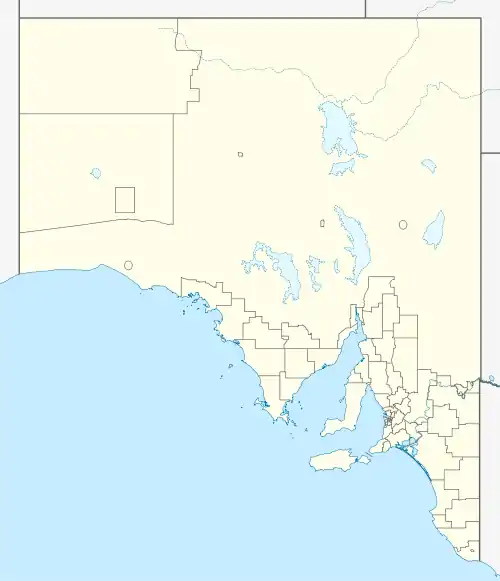Pullen Island Conservation Park
Pullen Island Conservation Park is a protected area includes all of Pullen Island about 0.5 kilometres (0.31 miles) south of Port Elliot in South Australia and about 94 kilometres (58 miles) south of Adelaide.[4]
| Pullen Island Conservation Park South Australia | |
|---|---|
IUCN category Ia (strict nature reserve)[1] | |
 Pullen Island Conservation Park | |
| Nearest town or city | Port Elliot |
| Coordinates | 35°32′16.96″S 138°41′29.13″E[1] |
| Established | 16 March 1967[2] |
| Area | 2 hectares (4.9 acres)[3] |
| Visitation | level unknown (in 1983)[4]:23–24 |
| Managing authorities | Department for Environment and Water |
| See also | Protected areas of South Australia |
The park was proclaimed in 1972 under National Parks and Wildlife Act 1972 replacing earlier protected area status as a Fauna Conservation Reserve which was proclaimed in 1967. The protected area status exists to protect the island as a breeding area for sea birds such as little penguins and silver gulls.[4]
The conservation park is classified as an IUCN Category IA protected area.[1] In 1980, it was included on the now-defunct Register of the National Estate.[5]
References
- "Terrestrial Protected Areas of South Australia (refer 'DETAIL' tab )". CAPAD 2016. Australian Government, Department of the Environment (DoE). 2016. Retrieved 21 February 2018.
- "CROWN LANDS ACT, 1929–1966: FAUNA CONSERVATION RESERVES DEDICATED" (PDF). THE SOUTH AUSTRALIAN GOVERNMENT GAZETTE. Government of South Australia. 16 March 1967. pp. 961–962. Retrieved 19 December 2018.
- "Protected Areas Information System Reserve List" (PDF). Government of South Australia. 9 March 2018. Retrieved 26 April 2018.
- Island conservation parks of Backstairs Passage and Encounter Bay management plans (PDF). Adelaide: National Parks and Wildlife Service, Department of Environment and Planning. 1983. pp. iii, 23–29. ISBN 0-7243-4588-4.
- "Pullen Island Conservation Park, Freeman Nob, Port Elliot, SA, Australia – listing on the now-defunct Register of the National Estate (Place ID 7635)". Australian Heritage Database. Department of the Environment. 21 October 1980. Retrieved 19 December 2018.
This article is issued from Wikipedia. The text is licensed under Creative Commons - Attribution - Sharealike. Additional terms may apply for the media files.